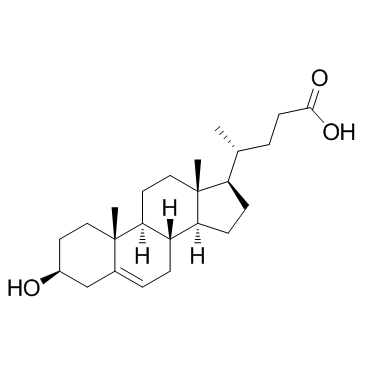Unusual serum bile acid pattern in children with the syndrome of hepatic ductular hypoplasia.
A Hernanz, R Codoceo, P Jara, C Diaz
文献索引:Clin. Chim. Acta 145(3) , 289-96, (1985)
全文:HTML全文
摘要
Fasting bile acids in serum of eight children with the syndrome of hepatic ductular hypoplasia were analyzed by gas chromatography. The children did not receive any kind of treatment during the month before the analysis. Serum concentrations of total bile acids ranged from 110.8-303.7 mumol/1. The predominant bile acids were chenodeoxycholic and cholic acids accounting for 62.8-86.5% of the total. The ratio of cholic acid to chenodeoxycholic acid ranged between 0.43 and 1.11. Monohydroxylated bile acids were found in increased amounts in all patients (5.1-23.9%), 3 beta-hydroxy-5-cholenoic acid being the major monohydroxylated bile acid (3.1-17.1%). Other unusual bile acids such as ursodeoxycholic acid and 12-oxo-3 alpha, 7 alpha-dihydroxy-5 beta-cholanoic acid (7.3-14.9%) were also detected. Neither 3 beta-hydroxy-5-cholenoic nor lithocholic acid levels were statistically correlated to cholic or chenodeoxycholic acids. However, a statistically significant correlation between total bile acid levels and 12-oxo-3 alpha, 7 alpha-dihydroxy-5 beta-cholanoic acid levels was found. These findings are interesting as far as the origin of the unusual bile acids found in this cholestatic syndrome is concerned. The large amounts of 3 beta-hydroxy-5-cholenoic acid measured in children with the syndrome of hepatic ductular hypoplasia could indicate the existence of an alternative fetal pathway of bile acid synthesis.
相关化合物
| 结构式 | 名称/CAS号 | 分子式 | 全部文献 |
|---|---|---|---|
 |
3β-羟基-Δ5-胆烯酸
CAS:5255-17-4 |
C24H38O3 |
|
Hepatic bile salt sulfotransferases in the rat: sulfation of...
1991-02-01 [J. Pediatr. Gastroenterol. Nutr. 12(2) , 260-8, (1991)] |
|
Determination of 3 beta-hydroxy-5-cholen-24-oic acid and its...
1984-07-01 [Steroids 44(1) , 47-55, (1984)] |
|
Purification and properties of a novel sulfatase from Pseudo...
1998-09-01 [Biosci. Biotechnol. Biochem. 62(9) , 1739-44, (1998)] |
|
Preparation and antigenic property of methyl 3 beta-hydroxy-...
1983-02-01 [Steroids 41(2) , 155-64, (1983)] |
|
Metabolism of 27-, 25- and 24-hydroxycholesterol in rat glia...
1997-02-15 [Biochem. J. 322 ( Pt 1) , 175-84, (1997)] |